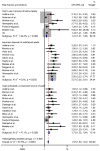Prevalence and risk factors of diarrhea among under-five children in Ethiopia: A systematic review and meta-analysis
- PMID: 40380143
- PMCID: PMC12082876
- DOI: 10.1186/s12889-025-22939-2
Prevalence and risk factors of diarrhea among under-five children in Ethiopia: A systematic review and meta-analysis
Abstract
Introduction: In developing countries, safe piped drinking water is generally unavailable, and bottled water is unaffordable for most people. In these countries, diarrhea accounts for the largest cause of disease and nearly 50% of deaths in young children. In Ethiopia, childhood diarrhea is a serious public health issue that affects 13.5 to 30.5% of the children with different diarrheal causes. Nonetheless as of late for work, no thorough comprehensive review for the pooled prevalence of diarrhea as well as the risk factors has been conducted, which was the goal of this systematic review and meta-analysis.
Methods: A Search was conducted of numerous international databases, including PubMed, Medline, Embase, Direct Science, Web of Science, Cochrane Library, Global Health, Google Scholar, CINAHL and University Repository. Articles from the last ten (10) years ranged from 2015 to mid-2024 were included. Using a common data extraction format, three authors extracted all required data. The statistical program STATA Version 17 was used to analyze pooled prevalence of diarrhea and the risk factors among children under five years old. The heterogeneity of the studies was evaluated using the I2 test and the Cochrane Q test statistics. Pooled prevalence of diarrhea and risk factors were calculated. The random effect model was utilized to investigate the relationships between risk factors and prevalence of diarrhea at national level. The random effect size was deemed to be less than 0.05 at a confidence interval of 95% (CI:95%).
Result: Out of 2548 studies, 36 studies were eligible for the review from north, southern, central, eastern and western part of Ethiopia. Regarding mothers/caregivers, out of 29,881 total populations, 10,641(36%) them were accessed from the national data reported by single study, 7438 (25%) and 5882(20%) were extracted from studies conducted in the northern and eastern Ethiopia, respectively. The pooled prevalence of two weeks diarrhea among children under five years old for the last ten years was 19.62% (95%CI:15.93, 23.31). Of this, 19.82% (95% CI:12.74-26.90%) and 19.83 (95% CI:15.31-24.36%) were between the interval of 2015-2019, and 2020- mid-2024, respectively. The pooled adjusted odds of improper disposal of child feces (AOR:3.33, 95% CI:2.70, 4.11), unvaccinated against Rota virus (AOR:1.81,95% CI:1.55, 2.12) and low maternal education (AOR:1.05, 95%CI:1.00, 1.11) were the risk factors for the prevalence of diarrhea among children under five years old. Meanwhile, the pooled adjusted odds of unimproved latrine (AOR:1.27, 95% CI:1.21, 1.35), improper waste disposal (AOR:2.57,95% CI:2.35, 2.81) and utilized untreated water (AOR:1.72, 95% CI:1.52, 1.94) were the significant risk factors. Also, adjusted odds for lack of handwashing (AOR:3.12, 95% CI:2.52, 3.88) and absence of handwashing during critical times (AOR:3.27,95%CI:3.06,4.49) were the risk factors.
Conclusion: A number of risk variables contribute to diarrhea morbidity among children under five years old, which was substantially correlated with water, hygiene and sanitation, illiterate mothers and access to a safe water source. Effective interventions such as promotion and education of proper hygiene, sanitation, proper hand washing; latrine installation at the household and community level; household-based chlorination; and improved water storage to prevent diarrhea among these age group is recommended.
Keywords: Children under five years; Diarrhea; Ethiopia; Prevalence; Risk factors.
© 2025. The Author(s).
Conflict of interest statement
Declarations. Ethics approval and consent to participate: Not applicable. Consent for publication: Not applicable. Competing interests: The authors declare no competing interests.
Figures








References
-
- IGME U. Child and Adolescent Causes of Death Estimation (CA CODE) project (2023). available at https://data.unicef.org/topic/child-health/diarrhoeal-disease/treatment%... 2023.
-
- WHO. World Health Organization: Diarrhoeal disease: Accessed on January 2024. Available at https://www.who.int/news-room/fact-sheets/detail/diarrhoeal-disease. 2024.
-
- Kumar SG, Subitha L. Diarrhoeal diseases in developing countries: a situational analysis. Kathmandu Univ Med J (KUMJ). 2012;10(38):83–8. 10.3126/kumj.v10i2.7351. - PubMed
Publication types
MeSH terms
LinkOut - more resources
Full Text Sources
Medical

